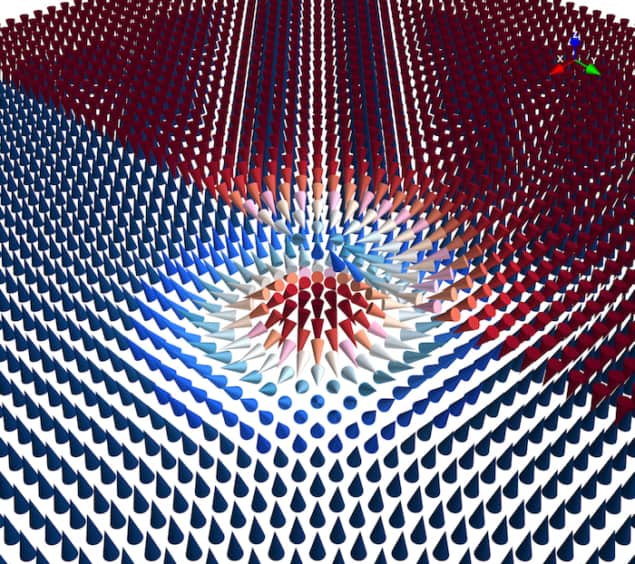
Researchers have succeeded in stabilizing antiferromagnetic skyrmions in an ordinary material system at room temperature for the first time. The new result will be important for future real-world applications that make use of these tiny magnetic particle objects.
Magnetic skyrmions are quasiparticle magnetic spin configurations with a swirling vortex-like structure. They can be thought of as 2D knots (or “spin textures”) in which the magnetic moments rotate about 360° within a plane. They were first discovered about ten years ago in non-centrosymmetric manganese-silicon and cobalt-iron-silicon crystals, but they are now known to occur in a wide range of materials, including ultra-thin magnetic multilayers, which are much more compatible with potential future applications.
Magnetic skyrmions could be used as storage bits in next-generation memories that have a much higher density than today’s disk drives thanks to their small size and the fact that they can be efficiently controlled with spin currents. They are also robust to external perturbations.
In recent years, researchers have made skyrmions in low-dimensional magnetic materials and in nanoscale thin-film multilayers. They have also isolated skyrmions as room-temperature metastable states in ferromagnets by applying an external magnetic field. However, measuring around 100 nm across, the structures made so far are still too big for competitive real-world applications. Ideally, they need to be reduced in size to the 10-nm range or smaller.
Dipolar interactions hinder skyrmion stabilization
One of the main difficulties in hosting skyrmions in ferromagnetic thin films or multilayers, however, is that dipolar interactions in these materials do not allow for such small skyrmions. They also make it extremely difficult to stabilize skyrmions without applying external magnetic fields.
Researchers at the CNRS/Thales/Paris-Sud University in France say they have now overcome this problem and have stabilized antiferromagnetic skyrmions in synthetic antiferromagnets (SAFs) – at room temperature. “The SAF systems we employed in our experiments are widely employed in industry,” explains study lead author William Legrand. “This means that we now have easy access to antiferromagnetic skyrmions, which were before restrained to more complex alloys called ferrimagnets under specific conditions at one particular working temperature only.”
The strategy works because antiferromagnets contain two coupled equivalent magnetic subsystems aligned antiparallel to each other, he explains. This arrangement has no net magnetic moment and thus does not generate a dipolar field.
Antiferromagnetic coupling
The researchers made their SAF by stacking several layers of different ferromagnetic and non-ferromagnetic metals (platinum, cobalt and ruthenium in this case) with individual layer thicknesses of around a nanometre (or just three to seven atoms-thick) in a periodic fashion. These ferromagnetic layers are coupled antiferromagnetically through a non-magnetic spacer layer by Ruderman-Kittel-Kasuya-Yoshida (RKKY)-type interlayer electronic coupling.
Just as in antiferromagnets, SAFs do not have any dipolar interactions. However, there may be a small but measurable local dipolar field because of the presence of the non-magnetic spacer. Far from being a nuisance, this field could actually help the researchers to image the antiferromagnetic skyrmions hosted in the SAFs using local probe techniques such as Magnetic Force Microscopy (MFM).
Stabilizing spin textures
The researchers stabilized a particular kind of spin texture in their SAF, which is a “spin-spiral”, by adjusting the individual layer thicknesses in the material. These spin textures can then be turned into antiferromagnetic skyrmions by coupling the SAF electronically to a third magnetic layer, itself robust and adjacent to the SAF. “This layer biases only one of the layers of the two that make up the SAF,” explains Legrand. “It thus defines the exterior of the skyrmions and allows them to be stabilized.”

Skyrmion phases: two for the price of two
We believe that this platform for experimentally obtaining antiferromagnetic skyrmions without the need for an external magnetic field could be used to miniaturize skyrmion-based devices to much smaller sizes, he tells Physics World.
The researchers, led by Nicolas Reyren, Vincent Cros and Albert Fert, say that they now plan to study the dynamics of these antiferromagnetic skyrmions in more detail. “We would also like to build more robust SAF assemblies to further reduce the minimal size of the skyrmions we have stabilized. We shall then be truly on the way to atomic-sized skyrmions at ambient conditions.”
Full details of the research are reported in Nature Materials 10.1038/s41563-019-0468-3.



